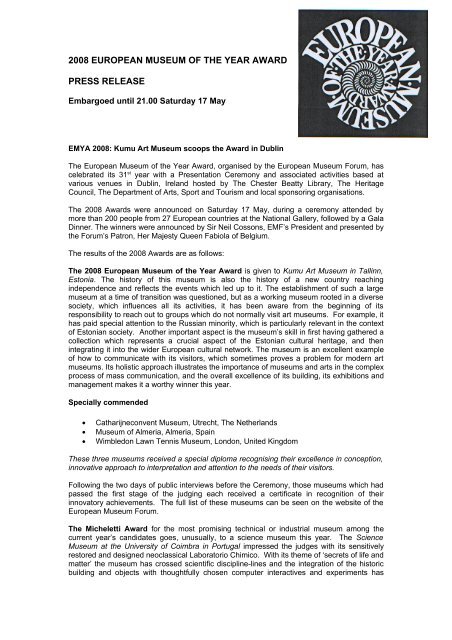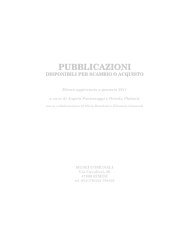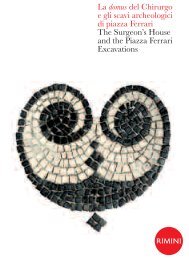2007 EUROPEAN MUSEUM OF THE YEAR AWARD - Musei di Rimini
2007 EUROPEAN MUSEUM OF THE YEAR AWARD - Musei di Rimini
2007 EUROPEAN MUSEUM OF THE YEAR AWARD - Musei di Rimini
You also want an ePaper? Increase the reach of your titles
YUMPU automatically turns print PDFs into web optimized ePapers that Google loves.
2008 <strong>EUROPEAN</strong> <strong>MUSEUM</strong> <strong>OF</strong> <strong>THE</strong> <strong>YEAR</strong> <strong>AWARD</strong><br />
PRESS RELEASE<br />
Embargoed until 21.00 Saturday 17 May<br />
EMYA 2008: Kumu Art Museum scoops the Award in Dublin<br />
The European Museum of the Year Award, organised by the European Museum Forum, has<br />
celebrated its 31 st year with a Presentation Ceremony and associated activities based at<br />
various venues in Dublin, Ireland hosted by The Chester Beatty Library, The Heritage<br />
Council, The Department of Arts, Sport and Tourism and local sponsoring organisations.<br />
The 2008 Awards were announced on Saturday 17 May, during a ceremony attended by<br />
more than 200 people from 27 European countries at the National Gallery, followed by a Gala<br />
Dinner. The winners were announced by Sir Neil Cossons, EMF’s President and presented by<br />
the Forum’s Patron, Her Majesty Queen Fabiola of Belgium.<br />
The results of the 2008 Awards are as follows:<br />
The 2008 European Museum of the Year Award is given to Kumu Art Museum in Tallinn,<br />
Estonia. The history of this museum is also the history of a new country reaching<br />
independence and reflects the events which led up to it. The establishment of such a large<br />
museum at a time of transition was questioned, but as a working museum rooted in a <strong>di</strong>verse<br />
society, which influences all its activities, it has been aware from the beginning of its<br />
responsibility to reach out to groups which do not normally visit art museums. For example, it<br />
has paid special attention to the Russian minority, which is particularly relevant in the context<br />
of Estonian society. Another important aspect is the museum’s skill in first having gathered a<br />
collection which represents a crucial aspect of the Estonian cultural heritage, and then<br />
integrating it into the wider European cultural network. The museum is an excellent example<br />
of how to communicate with its visitors, which sometimes proves a problem for modern art<br />
museums. Its holistic approach illustrates the importance of museums and arts in the complex<br />
process of mass communication, and the overall excellence of its buil<strong>di</strong>ng, its exhibitions and<br />
management makes it a worthy winner this year.<br />
Specially commended<br />
• Catharijneconvent Museum, Utrecht, The Netherlands<br />
• Museum of Almeria, Almeria, Spain<br />
• Wimbledon Lawn Tennis Museum, London, United Kingdom<br />
These three museums received a special <strong>di</strong>ploma recognising their excellence in conception,<br />
innovative approach to interpretation and attention to the needs of their visitors.<br />
Following the two days of public interviews before the Ceremony, those museums which had<br />
passed the first stage of the judging each received a certificate in recognition of their<br />
innovatory achievements. The full list of these museums can be seen on the website of the<br />
European Museum Forum.<br />
The Micheletti Award for the most promising technical or industrial museum among the<br />
current year’s can<strong>di</strong>dates goes, unusually, to a science museum this year. The Science<br />
Museum at the University of Coimbra in Portugal impressed the judges with its sensitively<br />
restored and designed neoclassical Laboratorio Chimico. With its theme of ‘secrets of life and<br />
matter’ the museum has crossed scientific <strong>di</strong>scipline-lines and the integration of the historic<br />
buil<strong>di</strong>ng and objects with thoughtfully chosen computer interactives and experiments has
proved very successful. Add to this a very varied programme of activities and a high standard<br />
of publications, and the resulting experience for visitors is excellent.<br />
The Council of Europe Award, a bronze statuette by Miró, goes to Svalbard Museum at<br />
Longyearbyen in Norway. This lively museum has an unusual presentation of Svalbard’s<br />
400-year history, with a scenically designed inner sector allowing the visitors to make their<br />
own <strong>di</strong>scoveries, and an educational outer ring that can be reached easily from outside, with<br />
easy access between the two. The museum is a source of expertise in natural research and<br />
education and is convinced that its exhibitions on the con<strong>di</strong>tions necessary to support life and<br />
activities in the Arctic, and on global climate can influence the future behaviour of its visitors.<br />
The result for those who come to the museum is entertaining, instructive and thoughtprovoking.<br />
This award was presented at a separate ceremony in Strasbourg on 15 April 2008.<br />
The European Museum Forum: what it is and what it does<br />
The Forum is responsible to the European Museum Forum Trust, a charity registered in the<br />
United Kingdom (282158), and operating under the auspices of the Council of Europe. In<br />
ad<strong>di</strong>tion to hol<strong>di</strong>ng the European Museum of the Year Award, it organises Museum<br />
Workshops at <strong>di</strong>fferent places in Europe, publishes a quarterly Bulletin and runs an advisory<br />
and consultancy service.<br />
Its day-to-day operation is controlled by an international committee, composed of men and<br />
women influential in the museum and cultural fields and it is a wholly independent body,<br />
deriving its income from membership and entrance fees and various forms of sponsorship. It<br />
considers that its main duty is to the public, but it maintains good relations with both national<br />
and international professional organisations.<br />
The can<strong>di</strong>dates for its Award are new museums, established within the past two or three<br />
years, and older museums which have been completely reorganised during the same period.<br />
It receives applications from between 50 and 60 can<strong>di</strong>dates a year, all of whom receive<br />
assessment visits from members of the Forum’s judging committee, who constitute a<br />
European flying squad, which goes from country to country encouraging, comforting,<br />
criticising and offering practical advice. This is something new and unique in the museum<br />
world. So far more than 1500 museums in 40 countries have taken part in the EMYA<br />
scheme.<br />
The Forum considers itself to be European in the most profound sense of the word, a focus of<br />
cultural understan<strong>di</strong>ng. Its opinions are expressed in plain terms, and its aim each year, in<br />
selecting the European Museum of the Year, is to <strong>di</strong>scover and publicise a museum which<br />
has succeeded outstan<strong>di</strong>ngly well in dealing with the problems that are facing museums<br />
everywhere, problems of imagination, money, staff morale, bureaucracy, integrity and<br />
professional pride, taste, social responsibility and planning for the future.<br />
For more information please visit www.europeanmuseumforum.org or contact Ann Nicholls on<br />
mail@europeanmuseumforum.org; emforum@emforum.plus.com; telephone 0044 117 923<br />
8897; fax 0044 117 973 2437.





